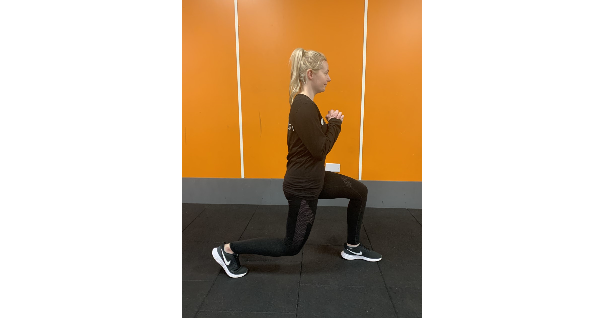Lunges are a fantastic leg exercise that target muscles including quads, hamstrings, glutes, calves, as well as working your abdominals from challenging your balance and stability. There are so many variations of a lunge starting from your basic bodyweight lunge and moving up through a wide number of progressions to increase difficulty.
Basic lunge variations:
- Forwards
- Reverse
- Walking
- Side (lateral)
Forward lunge:
- Keep your body upright and looking ahead
- Engage your core
- Step forwards with one leg and lower yourself until both legs are bent at around a 90 degree angle
- Ensure your front knee isn’t too far forwards – aim for it being directly above your ankle
- Keep the weight in your front heel as you push back to standing position
Reverse lunge:
- Exactly the same as above – body upright, looking ahead, core engaged
- Step backwards with one leg and lower until both legs have around a 90 degree bend
- Keep the weight in the front leg and push into this heel to step in and drive back up to the starting position
Walking lunge:
- Exactly the same as above – body upright, looking ahead, core engaged
- Step forwards with one leg until you reach the 90 degree bends in both legs
- From here drive up with the front leg and step through with the other leg
- Place this leg in front and again achieve those 90 degree bends in both legs
- Repeat again on the other side
Side (lateral) lunge:
- Start the same as above – standing tall, body upright, core engaged
- Take a big step out to the side
- Lower yourself from the hips until the knee of your leading leg is around a 90 degree bend
- Keep your trailing leg straight
- Push into the leading leg back up to the starting position
Lunges can be modified in so many ways from adding weight to adjusting the tempo, repeating on the same side or alternating legs, as well as using equipment such as TRX and adjusting the height of where you are stepping to or from.
Some people suffer with straining their knees when performing lunges, so if this is the case then it is a good idea to reduce the range of motion and start with smaller steps as this will still improve your strength and help to develop your alignment. From here you can then slowly increase the distance of your step and build it up.
If you would like help with your lunge technique or some ideas for you to try out and progress with then our team of instructors will be more than happy to help you. Grab us in the gym or book an appointment with one of us at reception.
Jo Davies – Level 3 Personal Trainer

